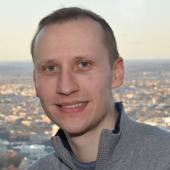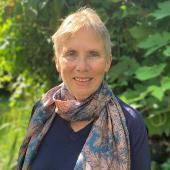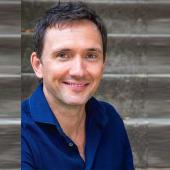Biologically inspired physics is an extraordinarily wide field, covering the behaviour of systems from single-molecule machines to organisms, ecosystems and evolution. We use the tools of physics to address biological problems and we use biology to create new tools of physics. Our work at the interface between disciplines impacts medicine and healthcare as well as the biological and physical sciences and industry.
Most of our experimental biophysics research is located in the Kavli Institute for Nanoscience Research in a state-of-the-art new building completed in 2021 and dedicated to high-risk, high-reward research ‘to catalyse discovery by bringing the physical sciences into the cell’. The institute provides shared infrastructure and brings together collaborating groups from across physical and life sciences in Oxford.
Biomolecular motors and machines
Rotary molecular motors are essential agents of movement and energy transduction in living organisms and our biophysics of molecular motors group, led by Richard Berry, focuses in particular on the bacterial flagellar motor and F1FO ATP synthase. The group uses novel forms of light microscopy to understand how these complex machines work and how they are built, maintained and controlled in living cells.
Gene expression is the vital path that converts DNA information into functional proteins, RNA machines and a wide variety of signals. Our gene machines group is led by Achillefs Kapanidis and studies mechanisms and machines of gene expression of microbial pathogens using single-molecule biophysical methods and biochemistry. The group also develops single-molecule fluorescence methods and assays for pathogens such as viruses and antibiotic-resistant bacteria.
The copying or replication of DNA is one of the central processes in all living organisms. In the Lab of Replication Dynamics, led by Nynke Dekker, we aim to understand the molecular processes underlying DNA and RNA replication and to gain spatiotemporal insight into their dynamics. We use cutting-edge single-molecule biophysical tools, such as fluorescence and force spectroscopy, which provide a complementary approach to bulk biochemistry and address relevant questions about replication dynamics that cannot be addressed otherwise. Our current focus is on eukaryotic DNA replication, including the chromatin context, while maintaining an interest in bacterial and viral systems.
Research in the Chromatin Dynamics Lab, led by Dominika Gruszka, centres on physical and molecular mechanisms underpinning chromatin dynamics during DNA replication. We combine single-molecule imaging, biochemical and biophysical approaches to understand how epigenetic information is maintained in time.
Using DNA and RNA as a construction material, we study the design and assembly of molecular machines that mimic biological machinery. The nucleic acid nanotechnology group, led by Jon Bath, aims to create probes of cellular structure and function and develop disruptive technologies for the physical sciences and molecular manufacturing.
Ion channels
Our work with ion channels is led by Stephen Tucker and focuses on the intimate relationship between ion channel structure and function at an atomic level and the role of ion channels in health and disease. The ion channels group works primarily with K2P potassium channels and uses a range of computational, biophysical and electrophysical approaches to study their properties.
Biomechanics
Sonia Contera leads a biomechanics and scanning probe group investigating how mechanical properties of cells and tissues are coupled to chemistry and electricity to create biological function. The group uses atomic force microscopy to measure structures and mechanical properties with nanometre accuracy in living systems and works at the interface of physics, biology and nanotechnology.
Statistical physics and simulation of biological systems
Work in statistical biophysics, led by Ard Louis, applies theoretical and computational tools from statistical mechanics to study the emergence of complex behaviour from the interaction of many individual objects. The statistical biophysics group focuses on the physics of evolution and of self-assembly, including coarse-grained simulation of nucleic acid interactions and nanostructures, algorithmic information theory and deep learning.
Julia Yeomans leads a theory of soft and active matter group that addresses a variety of problems in soft matter and biological physics using theoretical and computational tools from statistical mechanics and hydrodynamics. They are particularly interested in the dynamics of soft-matter, motility at low Reynolds number, the interactions of fluids with structured surfaces, and active systems including dense suspensions of swimming bacteria and the mechanobiology of tissues.



